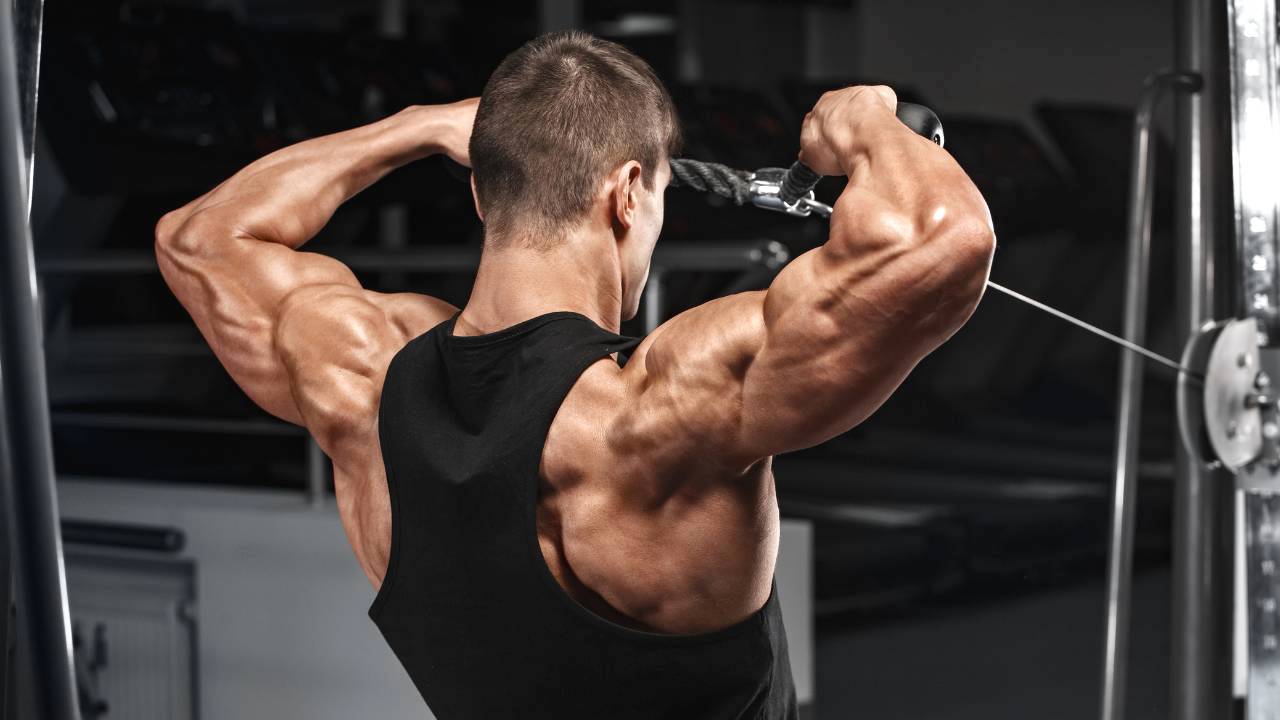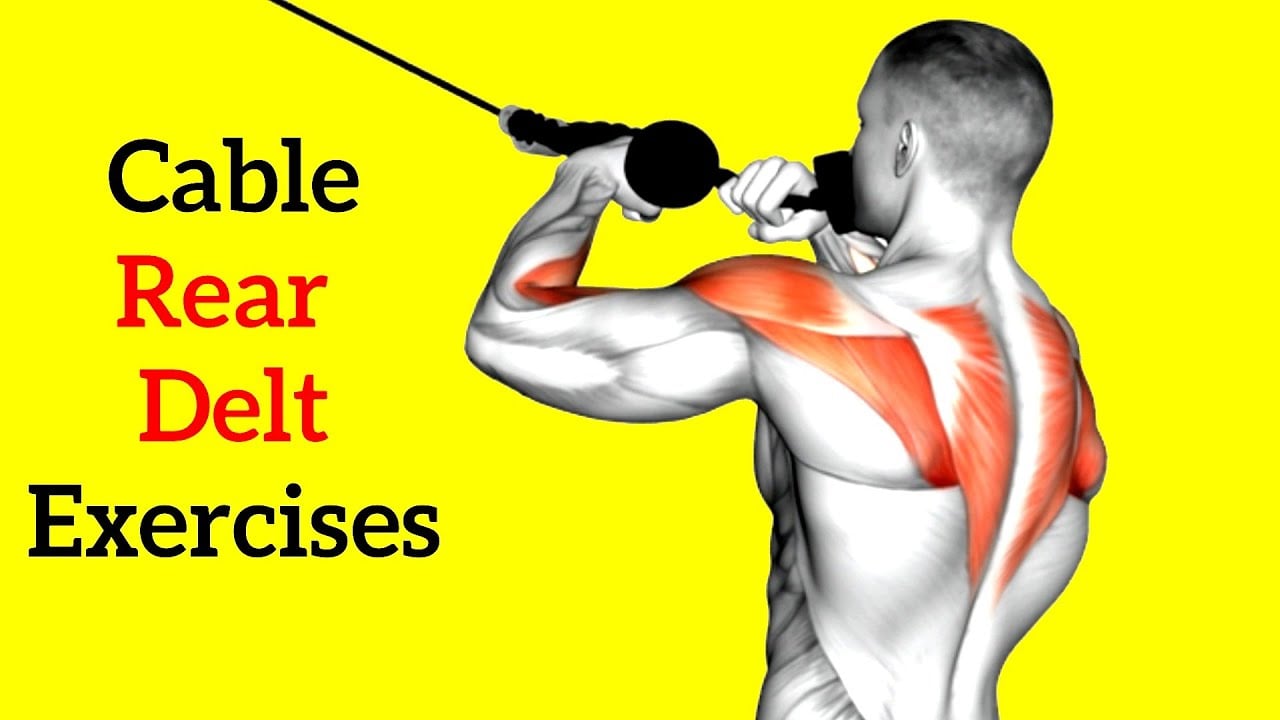Many people overlook their rear deltoids completely, and this mistake can cost them not only in aesthetics, but also in overall shoulder health and functional strength.
But you are not like 95% of gym-goers who don’t train rear delt.
GREAT, Then this BLOG Is for you.
In this data-backed guide, I’m breaking down the 12 most effective rear delt exercises that will transform your shoulder development.
There will be no fluff or bro-science—just proven strategies backed by exercise science and real-world results.

- Anatomy & Function of the Rear Deltoid
- Anterior Deltoid
- Lateral Deltoid
- Rear Deltoid
- Rear Delt Exercises For Mass And Strengthening
- 1. seated Rear Delt Fly
- 2. Machine Rear Deltoid Fly
- 3. Bent Over Cable Rear Delt Fly
- 4. Incline Bench Rear Delt Fly
- 5. One Arm Dumbbell Rear Delt Row
- 6. Reverse Cable Crossover
- 7. Face Pull
- 8. Lying Dumbbell Rear Delt Row
- 9. Side-Lying Rear Delt Fly
- 10. Dumbbell Head Supported Row
- 11. Cable Machine Y Raise
- 12. One Arm Bent-Over Cable Raise
- How To Train Rear Deltoid Muscles
- 1. Train The Rear Deltoid With a Back Workout
- 2. Train Posterior Delts Twice Per Week
- 3. Prioritize Rear Delts On Shoulder Day Among The Three Delt Heads
- 4. Choose A Solid Mass-Builder (Compound Workout)
- 5. Use Advance Techniques
- FAQs
- What are the best exercises to train the rear deltoid?
- Can I do rear delt exercises at home?
- Are Rows Good For Rear Delts?
- How Many Sets and Reps Should I Do?
- What Is The Fastest Way To Build Rear Delts?
- Is Rear Deltoid Row a Back Exercise?
- Conclusion
- References
Anatomy & Function of the Rear Deltoid
The deltoid muscle of the shoulder consists of three separate sections or heads.
- The anterior deltoid (In front)
- Lateral deltoid (at the side)
- Rear deltoid (posterior or behind)
Anterior Deltoid
It is commonly called the front delt. It originates from your collar bone and inserts into your humerus (upper arm bone).
The main function of your front delt is to move your arm up, forward, and to your centre.

Lateral Deltoid
It has several common names, such as side, middle, or outer delts. It arises from a small area on your shoulder blade called the acromion process and inserts into your humerus.
Your lateral delt’s main function is shoulder abduction, bringing it up to the side.
Rear Deltoid
Rear Delt is also known as the Posterior Deltoid. It arises from your scapula (upper part of your shoulder blade) and inserts into your humerus.
Your posterior deltoids’ main function is moving the arm outward and backwards. They are also responsible for the external rotation of the shoulder.
The rear delts are involved in many pulling exercises and act as stabilizers.
Try Our FREE Workout Planner to generate your customized workout plans
Rear Delt Exercises For Mass And Strengthening
Here are the 12 best rear delt exercises for maximum posterior deltoid growth, using various types of fitness equipment.
- Posterior delt exercises with dumbbells
- Barbell & machine rear delt exercises
- Posterior delt workouts with cables
1. seated Rear Delt Fly
The bent-over dumbbell lateral raise, also called the rear delt fly, is a great exercise for building a complete set of shoulders. It is an excellent exercise to isolate and work specifically on rear deltoid muscles.
Scientific research backs this up, too. Studies have shown that this exercise works the rear deltoid muscles like nothing else, so it’s necessary in any shoulder training routine. The beauty of this move is its flexibility – you can do it standing or seated, depending on your preference and comfort.
Personally, I’m a fan of the seated version. It forces you to maintain strict form, and there’s less room for cheating or using momentum.
How To Do
- Sit at the end of a bench with a pair of dumbbells.
- Bend forward and let the dumbbells hang on your sides.
- Lift the dumbbells on your sides and raise them slightly higher than your shoulders.
- Now lower the dumbbells back to your sides.
- Keep strict form to isolate the rear delts.
2. Machine Rear Deltoid Fly
A study has shown that the reverse peck deck is the best exercise for working the posterior part of the deltoid muscle.
Machine rear deltoid fly machine provides a uniform resistance and controlled movement throughout the range of motion.
Additionally, the machine allows for an isolated workout, targeting the rear deltoids specifically.
How To Do
- Sit facing the rear deltoid machine with your chest against the backrest.
- Grasp the handles directly in front of, arms outstretched at shoulder level.
- Pull the handles back in an arc as far as possible. Keep your elbows high and arms parallel to the floor.
- Return the handles to the start position directly in front.
3. Bent Over Cable Rear Delt Fly
The bent-over cable fly is your go-to move for transforming your rear deltoid and trapezius muscles.
It is performed by standing facing a cable machine with a D-handle attachment at hip height.
Unlike dumbbell raises, where the resistance feels like a rollercoaster – changing as you lift – cable machines are the smooth operators of the workout world. The magic is in the pulley system. The tension remains consistent from the moment you start the movement until you complete the rep.
How To Do
- Grab the handles attached to two low pulleys (left-side handle in right hand, right-side handle in left hand).
- Stand in the middle, then bend forward at the waist with the back straight and parallel to the floor.
- Raise your hands upward in an arc to shoulder level, so the cables cross over.
- Lower the handles back down to the start position, your right hand directly in front of the left ankle and your left hand in front of the right ankle.
4. Incline Bench Rear Delt Fly
The incline bench creates a unique angle that isolates your rear deltoids like nothing else. You will eliminate momentum and momentum cheating when you position yourself face-down on an angled bench.
This exercise targets such small muscles, so it is usually performed with lightweight weights for high reps (10–15 reps).
It provides many other benefits, such as it makes shoulders bigger, more balanced, and healthier.
How To Do
- Sit in the reverse direction on an incline bench (45 degrees) while holding dumbbells with neutral grips.
- Hold the dumbbells so that they hang straight down from your shoulders.
- Slowly lift the dumbbells up and out to the sides of your body, pulling through the rear delts and middle traps.
- Pause for a moment at the top of the motion before slowly lowering the weights back down to the starting position.
5. One Arm Dumbbell Rear Delt Row
Not all rows are created equal, and the rear deltoid row is proof of that.
Think of this as the more sophisticated cousin of the classic one-arm dumbbell row. While they might look similar at first glance, the rear deltoid row has a few tricks up its sleeve that make it uniquely effective.
How To Do
- Start by placing your right foot on the floor with your left knee resting upon a bench.
- Keeping your body weight supported by your left arm.
- While keeping your back flat, pick up a dumbbell in your right hand.
- Begin by leading up with your elbow, bringing your arm up close to your chest, and squeezing with your rear delt muscles.
- Once you reach the top of the exercise, stop and hold for a count, then return to the starting position.
- Switch sides and repeat.
Try Our FREE Workout Planner to generate your customized workout plans.
6. Reverse Cable Crossover
To target the rear deltoid, your arms should move directly back (and downward slightly), almost parallel to the floor.
If the hands are raised through a higher arc to a point above shoulder level, the trapezius and lateral deltoid contribute more to the movement.
Crossing your hands over one another (uncrossing the cables) at the start position increases the range of motion.
How To Do
- Stand in the center of a cable crossover apparatus.
- Start with hands crossed in front of you at shoulder height, with the left high cable in your right hand and the right in your left hand.
- Pull your elbows out and back as far as possible using your rear delts, then slowly return to the starting position.
- The posterior deltoid is best targeted with your torso upright, not leaning too far forward or back.
7. Face Pull
Face pull is a cable machine exercise that primarily targets the rear deltoid and, to a lesser degree, also targets the biceps, triceps, and traps.
Use a cable pulley machine to pull the weight straight toward your forehead.
This exercise prevents muscular imbalance and builds overall shoulder strength.
However, there are many face pull variations that you can try out, and they may require different types of equipment and setup.
How To
- Stand straight with feet in a comfortable, balanced stance.
- Grab the ends of the rope attachment using a neutral grip (palms facing each other) and slightly lean back.
- Pull the rope toward your face as you spread the ends so they end up on the sides of your ears just above your shoulders in the finish position.
- Hold this position for a second as you squeeze your shoulder blades together, contracting rear delts and middle traps as hard as possible.
- Then, slowly return the rope to the start position and repeat for reps.
8. Lying Dumbbell Rear Delt Row
For anyone who’s ever felt the twinge of lower back discomfort during shoulder workouts, this exercise is your new best friend.
Positioning yourself face down on a bench or an incline reduces strain on your lower back. It’s all about pure, targeted muscle engagement.
Beginners may start with lighter weights to perfect their form, whereas more advanced lifters can increase their resistance to continue challenging their muscles.

How To Do
- Start off lying on an incline bench with a dumbbell in each hand extended out in front of you.
- Slowly pull the dumbbells up until your elbows are just above your shoulders.
- Once you reach the final position, hold
- for a count and squeeze your muscles.
- Slowly lowering the dumbbell back to the starting position. Repeat for as many reps and sets as desired.
9. Side-Lying Rear Delt Fly
The side-lying rear delt fly is a great unilateral exercise used to target rear delt muscles. Instead of lying on the floor, you can lie on a bench.
Additionally, performing the movement one side at a time allows you to focus on engaging the posterior deltoid muscle. This can be helpful for people who have weaker muscles on one side.
Lying on your side gives you a wider range of motion, which in turn helps you engage the rear delts more effectively.
How To
- Lie on your right side on the floor. Using a neutral grip, grab the dumbbell with your left hand.
- Exhale as you raise the dumbbell from the floor until it is almost vertical. Hold for a count of two.
- Inhale as you reverse the movement and lower the dumbbell towards the starting position.
- Stop before the dumbbell touches the floor.
- Repeat for the desired number of repetitions.
- Repeat the exercise on the opposite side with your right arm.
Know More: Rear Delt Fly: Muscles Worked, Benefits, Variations
10. Dumbbell Head Supported Row
First off, this isn’t your typical row. This variation is like the Swiss Army knife of rear delt exercises – it’s precise, targeted, and almost impossible to mess up.
The head support lets you focus 100% on feeling your back muscles contract with each rep.
How To Do
- Place an incline bench at a 30–45° angle.
- Grab a pair of dumbbells and lie prone on the bench with your head supported.
- Let the dumbbells hang straight down with your arms fully extended.
- Pull the dumbbells towards your body, squeezing your shoulder blades together at the top of the movement.
- Pause briefly before slowly lowering the weights back to the starting position.
- Keep the movement slow and controlled to engage the muscles effectively.
- Adjust the bench height if needed to maintain comfort and alignment.
11. Cable Machine Y Raise
The Cable Y Raise is classified as an auxiliary isolation exercise (lifts that focus on smaller muscle groups to help build strength) that operates within an open kinetic chain.
The mechanics involve a combination of shoulder abduction and flexion, with a slight external rotation at the shoulder joint as the arms are raised in a Y configuration.
The cable Y-raise effectively recruits all three heads of the deltoid muscle group—anterior, lateral, and posterior—through both isometric and dynamic contractions.
How To Do
- Attach D-handles to low pulleys on a cable machine. Adjust the weight to a manageable level.
- Stand facing the machine with your feet shoulder-width apart.
- Cross your arms over each other to grab opposite handles (right hand on left handle and vice versa) in a pronated grip.
- Lift your arms upward in a Y-shaped motion while keeping them straight.
- Squeeze your rear deltoids at the movement’s top before lowering back to the starting position.
12. One Arm Bent-Over Cable Raise
You can do this exercise using one arm at a time, allowing you to alter the range of motion. This unilateral version allows you to raise your hand higher and get a longer stretch at the bottom.
Stabilize your torso by resting your free hand on your thigh.
How To Do
- Lean forward at the hips, place your right hand on your thigh and hold a dumbbell in your left hand with your arm extended straight down.
- Raise the weight straight out to the side until your arm is parallel with the floor.
- Pause momentarily at the top of the motion before slowly lowering the weight back down to the starting position.
- Repeat with the right arm.
Know More: How To Perform The Chest Supported Row And Its Variations
How To Train Rear Deltoid Muscles
The rear deltoids are a small muscle group located at the back of the shoulders. When training your rear deltoids, it is important to remember these techniques.
If you’ve got only one or two go-to rear-delt exercises in your gym bag, it’s time for a bigger bag. Learning new movements and techniques can help you grow.
1. Train The Rear Deltoid With a Back Workout
Though your rear delt muscles are technically located in your shoulders, most people like to train them on back day, instead of integrating them into your usual upper-body series.
Your posterior delts are already getting involved during the back workout day. So, why not add one or two dedicated rear-delt exercises at the end of your back workout to finish the job?
2. Train Posterior Delts Twice Per Week
You can double up your rear-delt workouts during your training split, not your entire shoulder workouts.
It would be best to take enough rest days and not train back and shoulders on consecutive days.
To develop any major muscle group, including your posterior delts, it’s generally best to train it with 10-to-20 weekly sets.

3. Prioritize Rear Delts On Shoulder Day Among The Three Delt Heads
If your posterior delts are lagging and weaker, then prioritize your rear-delt single-joint isolation exercise before working the middle and front delts.
The part of your body that you work on first when you feel the most energetic will improve the fastest.
Taking your sets to muscle failure is an important aspect of building muscle size; going 1-2 sets past failure can really set you up for growth.
Reference Workout plan.
| Exercise | Sets | Reps |
|---|---|---|
| Barbell Shoulder Press | 3-4 | 10-12 |
| Bent-Over Dumbbell Reverse Flyes | 3-4 | 12-15 |
| Face Pulls | 3-4 | 12-15 |
| Single-Arm Dumbbell Rows | 3-4 | 10-12 |
4. Choose A Solid Mass-Builder (Compound Workout)
The “secret” to building well-developed rear delts is to get as strong as possible on compound exercises that train your posterior delts.
A good rule of thumb is that 80% of your time and energy should go into compound exercises that train your delts, and the remaining 20% can be given to rear delt isolation exercises and machines.
Choosing a weight at which you fail on the lower side of the 8-10 rep range is a solid muscle-building option.
5. Use Advance Techniques
The best techniques that work well with rear-delt movements are listed here.
- Forced Reps are best done with your partner standing behind you, giving you just enough help when you hit the sticking point to get another few reps.
- Drop sets are easy to do with dumbbells, machines, or cable exercises. When you reach muscle failure, reduce the weight by about 25% and start the set over again.
- Supersets: Two rear-delt movements back-to-back, with minimal rest between exercises. Rest only after you complete both movements.
FAQs
What are the best exercises to train the rear deltoid?
There are many exercises that work the posterior deltoid, but two main types are:
- Rear Delt Rows: These compound exercises target many other muscle fibres. Barbell and dumbbell rear delt rows are the best exercises for strengthening the posterior delt.
- Delt fly and lateral raises are isolation exercises targeting the posterior deltoid.
Can I do rear delt exercises at home?
Yes, Your options are primarily determined by the equipment you have.
You can do bodyweight rear delt exercises like the inverted Row and Reverse Plank.
If you have dumbbells, try the rear delt fly with dumbbells outlined above, such as the bent-over lateral raise and dumbbell rear delt row.
Are Rows Good For Rear Delts?
Yes, rows are a great exercise to strengthen the rear delts.
How Many Sets and Reps Should I Do?
For just about every exercise of the chest or shoulder, 3–4 work sets (the real work you do, not warm-up sets) is a good choice. But rep ranges fluctuate.
You can do as few as 5 reps on heavy presses and as many as 15–30 reps for accessory work.
What Is The Fastest Way To Build Rear Delts?
The fastest way to build your rear delts is to do isolation exercises specifically targeting them. While pulling exercises like lat pulldowns and seated rows hit the rear delts, EMG data has proven that more isolated movements like a reverse fly on the pec deck recruit and activate the rear delts much faster.
Is Rear Deltoid Row a Back Exercise?
The short answer is yes; the rear deltoid is considered a back exercise, too. However, it doesn’t only work on your back but other upper body parts, too.
Its main focus is not the back but your arms and shoulders, though it can also strengthen your upper back.
Conclusion
Many exercises are claimed to work your rear deltoids. However, the ones contained in this article are the most effective. If you’re looking for the Best Rear Delt Exercises, then these are highly recommended.
If you’re interested in getting the best shape and improving the functionality of your shoulders, focus on your rear deltoids rather than just on your front and lateral deltoids.
These exercises allow targeted muscle development and provide a 3D look to the shoulder.
If you consistently do these rear delt exercises, you will improve the stability and shape of the rear deltoid.
Thanks for reading, enjoy Rear delt exercises!
References
- Brown, JM; Wickham, JB; McAndrew, DJ; Huang, XF (2007). “Muscles within muscles: Coordination of 19 muscle segments within three shoulder muscles during isometric motor tasks“. J Electromyogr Kinesiol. 17 (1): 57–73. doi:10.1016/j.jelekin.2005.10.007. PMID 16458022
- De Azevedo Franke R, Ehlers Botton C, Rodrigues R, Silveira Pinto R, Silveira Lima C. Analysis of anterior, middle and posterior deltoid activation during single and multijoint exercises. J Sports Med Phys Fitness. 2015 Jul-Aug.
- Campos YAC, Vianna JM, Guimarães MP, Oliveira JLD, Hernández-Mosqueira C, da Silva SF, Marchetti PH. Different Shoulder Exercises Affect the Activation of Deltoid Portions in Resistance-Trained Individuals. J Hum Kinet. 2020 Oct; 75: 5–14. doi: 10.2478/hukin-2020-0033.
- Snarr, R.L., Nickerson, B.S. and Esco, M.R. (2014) Effects of hand-grip during the inverted row with and without a suspension device: An electromyographical investigation, European Journal of Sports & Exercise Science. Available at: https://www.scholarsresearchlibrary.com/abstract/effects-of-handgrip-during-the-inverted-row-with-and-without-a-suspension-device-an-electromyographical-investigation-7943.html.
- Botton, C. E., Wilhelm, E. N., Ughini, C. C., Pinto, R. S., & Lima, C. S. (2013). Electromyographical analysis of the deltoid muscle between different strength training exercises. Medicina Sportiva, 17(2), 67-71. https://doi.org/10.5604/17342260.1055261
- Campos, Y. A. C., Vianna, J. M., Guimarães, M. P., Oliveira, J. L. D., Hernández-Mosqueira, C., da Silva, S. F., & Marchetti, P. H. (2020). Different Shoulder Exercises Affect the Activation of Deltoid Portions in Resistance-Trained Individuals. Journal of Human Kinetics, 75(1), 5–14. https://doi.org/10.2478/hukin-2020-0033
- Snarr, R.L., Nickerson, B.S. and Esco, M.R. (2014) Effects of hand-grip during the inverted row with and without a suspension device: An electromyographical investigation, European Journal of Sports & Exercise Science. Available at: https://www.scholarsresearchlibrary.com/abstract/effects-of-handgrip-during-the-inverted-row-with-and-without-a-suspension-device-an-electromyographical-investigation-7943.html.
- Department of Physical Therapy and Movement Science, P.R. (2016) The Inverted Row : Strength & Conditioning Journal, LWW. Available at: https://journals.lww.com/nsca-scj/fulltext/2014/08000/the_inverted_row.13.aspx.

Manish is a NASM-certified fitness and nutrition coach with over 10 years of experience in weight lifting and fat loss fitness coaching. He specializes in gym-based training and has a lot of knowledge about exercise, lifting technique, biomechanics, and more.
Through “Fit Life Regime,” he generously shares the insights he’s gained over a decade in the field. His goal is to equip others with the knowledge to start their own fitness journey.


